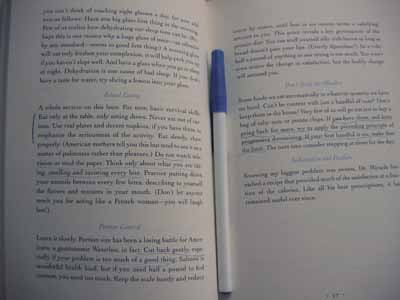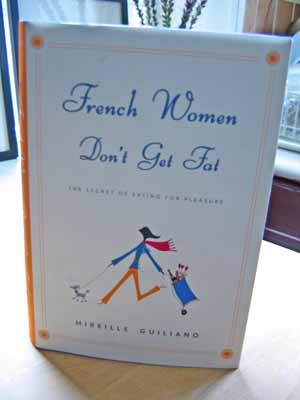
Last night I had dinner with my friend and former publishing colleague A, who is half-French and lost quite a few pounds while visiting there for a month recently. Having heard much about a new book called French Women Don’t Get Fat, naturally I asked her what she thought about the whole idea. To my delight, she reached into her bag and pulled out a copy she’d brought for me—I hadn’t realized it, but her company publishes it. What began as a browse during the subway ride home turned into a full-court read, complete with underlined passages and exclamation points. As I get further into it I’ll write more, but so far it’s a near-ephiphany. The writing is charming, and the focus is on pleasure, not deprivation. This may well be the diet book to end all diet books—though let’s be clear, it’s not a diet at all. It’s a philosphy. I’m not sure I agree with everything in it—the 48-hour jump-start with nothing but leek soup (aka leeks cooked in water, period) strikes me as diet trickery—but many of the techniques the author discusses seem pretty sound overall. Common sensey.
The most eye-opening suggestion is the idea of the Eating Ritual, making enjoyment of your food the point of eating. No distractions. Just eating, and thinking about the flavors as you take each forkful into your mouth. For years, Weight Watchers has told me never to eat standing up, never to eat with my hands, to sit at a dining table, to put my fork down between bites. I’ve never really paid attention to that, even though it makes sense, because it always struck me as little more than a parlor trick for my stomach. The way Mireille Guiliano, the author, explains it, it’s less about sleight-of-hand (sleight-of-fork?) and more about pleasure. Pleasure, I can endorse wholeheartedly.

My first experiment with the Eating Ritual (which I’m tempted to call “conscious eating,” but that makes it sound too American and woo-woo, doesn’t it?) was with oatmeal. I could eat oatmeal every day—nothing fills me up better, or longer, and the warm, comforting softness of it is a gentle way to float into the day. To my distinct pleasure, it’s one of Weight Watchers’ cherished Core Foods—things one can eat without limit, until satisfied. My preferred preparation is with raisins, brown sugar, and toasted pecans; alas, none of those things is a Core Food, which means my daily morning bowl would chip away at my limited supply of weekly Flex Points. All this is a long way of saying that I’ve been experimenting with other ways to eat my oatmeal. Eliminating all but one of the three items was the goal. Swapping the brown sugar for Equal was easy. Less easy was dropping either the nuts or the raisins. As luck would have it, though, the book has a recipe for oatmeal with grated apples—an addition that never would’ve occurred to me, even though as a child I’d always select the Apples & Cinnamon packet from the big box of assorted Quaker Instant. Grated apples, toasted pecans, half a packet of Equal, a dusting of cinnamon, and a few glugs of low-fat milk was my inaugural ritual meal.
Now, I should point out that S and I don’t have a dining room—typically, we eat in the living room, off the coffee table, watching a DVD. Breakfast and many lunches are eaten at my desk, while I catch up on email or read the paper. As much as I love food, and love cooking, I’ve never been in the habit of paying much attention to the act of eating. According to Mireille, this is bad. Not only should I be sitting at a real dining table, I should be using cloth napkins and putting my utensil down every few bites, to rest and let my body register what I’ve eaten. Ah, well, you make do with what you’ve got—at least we use placemats! I carried my bowl of oatmeal into the living room and prepared to eat without distraction. This was much more difficult than I expected. Without a newspaper or television, at first I was anxious and jittery. I wanted to scoop huge spoonfuls into my mouth as quickly as possible, just to get the meal over with and move on to something productive. But I forced myself to think about what was going into my mouth, to try to differentiate the slightly-firm strands of grated apple from the pliant flakes of oatmeal, to note the full, rich crunch of the scattered toasted nuts. It was revelatory. This bowl of oatmeal tasted extraordinary. I slowed down to savor it, rolling the mixture on my tongue a bit, like a fine wine. According to Mireille, French women understand that the first few bites are the most enjoyable, and after that it simply becomes more of the same, which yields satisfaction from a smaller portion of any particular dish. To my astonishment, this turns out to be true. Two-thirds of the way through my bowl of oatmeal, a serving I’ve polished off in light-speed hundreds of times over the years, I was done. It was as much a function of becoming slightly bored with the sameness of each spoonful as it was with a feeling of satiety. Could it be that this technique will actually work?
S is skeptical (and I believe somewhat nervous about losing a dining companion he’s enjoyed for at least ten years), but he’s consented to try eating dinner without television for one week. I’ll report back after we’ve got a few days under our belts, or after the next révélation Francaise, whichever comes first.
Oatmeal with Grated Apple, Toasted Pecans, and Cinnamon
Adapted from French Women Don’t Get Fat
Serves 2
3 cups water
½ t. salt
1 ½ cups old-fashioned oatmeal
1 medium apple, coarsely grated
1 T. pecans, toasted and broken into small pieces
1 t. cinnamon
Low-fat milk (optional)
Bring the water and salt to a boil in a large saucepan, then add the oatmeal and lower the heat. Let it simmer for a minute, then add the apples. Cook until most of the water is absorbed but the oatmeal hasn’t yet begun to stick to the pot. Remove from the heat and cover. Divide between two bowls, and top with the toasted pecans and cinnamon. Add milk as desired.
